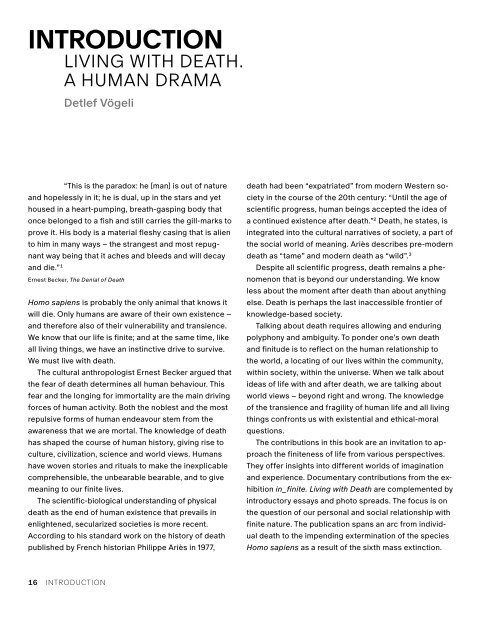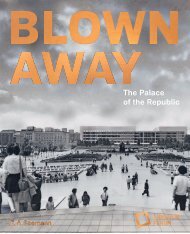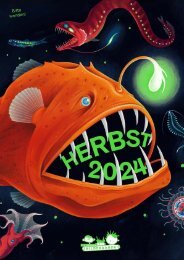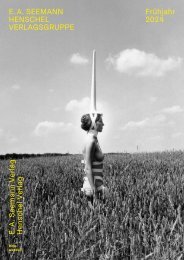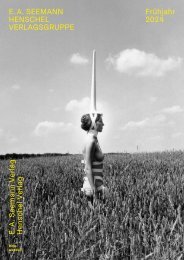Create successful ePaper yourself
Turn your PDF publications into a flip-book with our unique Google optimized e-Paper software.
<strong>IN</strong>TRODUCTION<br />
LIV<strong>IN</strong>G WITH DEATH.<br />
A HUMAN DRAMA<br />
Detlef Vögeli<br />
“This is the paradox: he [man] is out of nature<br />
and hopelessly in it; he is dual, up in the stars and yet<br />
housed in a heart-pumping, breath-gasping body that<br />
once belonged to a fish and still carries the gill-marks to<br />
prove it. His body is a material fleshy casing that is alien<br />
to him in many ways – the strangest and most repugnant<br />
way being that it aches and bleeds and will decay<br />
and die.” 1<br />
Ernest Becker, The Denial of <strong>Death</strong><br />
Homo sapiens is probably the only animal that knows it<br />
will die. Only humans are aware of their own existence –<br />
and therefore also of their vulnerability and transience.<br />
We know that our life is finite; and at the same time, like<br />
all living things, we have an instinctive drive to survive.<br />
We must live <strong>with</strong> death.<br />
The cultural anthropologist Ernest Becker argued that<br />
the fear of death determines all human behaviour. This<br />
fear and the longing for immortality are the main driving<br />
forces of human activity. Both the noblest and the most<br />
repulsive forms of human endeavour stem from the<br />
awareness that we are mortal. The knowledge of death<br />
has shaped the course of human history, giving rise to<br />
culture, civilization, science and world views. Humans<br />
have woven stories and rituals to make the inexplicable<br />
comprehensible, the unbearable bearable, and to give<br />
meaning to our finite lives.<br />
The scientific-biological understanding of physical<br />
death as the end of human existence that prevails in<br />
enlightened, secularized societies is more recent.<br />
According to his standard work on the history of death<br />
published by French historian Philippe Ariès in 1977,<br />
death had been “expatriated” from modern Western society<br />
in the course of the 20th century: “Until the age of<br />
scientific progress, human beings accepted the idea of<br />
a continued existence after death.” 2 <strong>Death</strong>, he states, is<br />
integrated into the cultural narratives of society, a part of<br />
the social world of meaning. Ariès describes pre-modern<br />
death as “tame” and modern death as “wild”. 3<br />
Despite all scientific progress, death remains a phenomenon<br />
that is beyond our understanding. We know<br />
less about the moment after death than about anything<br />
else. <strong>Death</strong> is perhaps the last inaccessible frontier of<br />
knowledge-based society.<br />
Talking about death requires allowing and enduring<br />
polyphony and ambiguity. To ponder one’s own death<br />
and finitude is to reflect on the human relationship to<br />
the world, a locating of our lives <strong>with</strong>in the community,<br />
<strong>with</strong>in society, <strong>with</strong>in the universe. When we talk about<br />
ideas of life <strong>with</strong> and after death, we are talking about<br />
world views – beyond right and wrong. The knowledge<br />
of the transience and fragility of human life and all living<br />
things confronts us <strong>with</strong> existential and ethical-moral<br />
questions.<br />
The contributions in this book are an invitation to approach<br />
the finiteness of life from various perspectives.<br />
They offer insights into different worlds of imagination<br />
and experience. Documentary contributions from the exhibition<br />
in_finite. <strong>Living</strong> <strong>with</strong> <strong>Death</strong> are complemented by<br />
introductory essays and photo spreads. The focus is on<br />
the question of our personal and social relationship <strong>with</strong><br />
finite nature. The publication spans an arc from individual<br />
death to the impending extermination of the species<br />
Homo sapiens as a result of the sixth mass extinction.<br />
Historical and cultural evidence suggests that humans<br />
have always done everything possible to postpone<br />
or overcome death – both factually and symbolically<br />
( Stephen Cave, p. 24).<br />
In many cultures, death was and is understood as a<br />
change of state, a transition into another form of existence.<br />
The promise of a life in the hereafter provides<br />
meaning and orientation – be it the idea of a paradise<br />
in Islam or Christianity, a moks· a in Hinduism, nirvana in<br />
Buddhism, or an ancestral world in the Yoruba religion.<br />
The aim is to lead a good life according to certain rules,<br />
to follow one’s personal dharma, to live in a God-conscious<br />
way. <strong>Death</strong> embeds the individual <strong>with</strong>in a larger narrative,<br />
<strong>with</strong>in a cosmology that provides a framework for<br />
behaviour and promises existence in a better world as a<br />
reward (Contemporary Notions of the Hereafter, p. 29).<br />
Dying and death are universal facts; the way we deal <strong>with</strong><br />
them is culturally and individually shaped (Helaine Selin,<br />
Robert M. Rakoff, p. 72). What counts in the last days,<br />
hours and minutes before death? What do people regret<br />
on their deathbed? What comforts them? How universal<br />
is the process of dying? What role do cultural and reli gious<br />
beliefs play at the end of life? Twelve individuals who<br />
accompany others to death at the end of their lives talk<br />
about their experiences and rituals (World <strong>Death</strong> Conference,<br />
p. 75).<br />
The neurologist and stroke researcher Jens Dreier<br />
has observed what happens in the brain during the final<br />
phase of dying. He speaks of the final wave of release<br />
before death. What happens after death at the level of<br />
consciousness remains a mystery: “Everything that is<br />
accessible to us happens while the patient is still alive.<br />
What might happen afterwards is not accessible to science”<br />
(Jens Dreier, p. 102).<br />
Rituals can provide comfort during the process of dying<br />
and beyond death. The bioarchaeologist Liv Nilsson<br />
Stutz examines how the universal crisis of death is dealt<br />
<strong>with</strong> in different cultures and the significance of the ritual<br />
care of the corpse. Behind the diversity of funeral rituals<br />
in different cultures lies a universal human need in the<br />
face of death. Beneath the surface, she explains, “we<br />
also discover that our vulnerability is the same, and the<br />
need to make sense of the world and what is happening<br />
to us is a shared human condition. It is in these moments<br />
that we can see ourselves in the other, and the other in<br />
ourselves. It is encounters like this that we can begin to<br />
grasp our shared humanity and the responsibility that<br />
that entails” (Liv Nilsson Stutz, p. 112).<br />
<strong>Death</strong> unites us – and death divides us. Although no<br />
one is privileged enough to escape physical death, we<br />
are not all equal in the face of death. Social and geographical<br />
origins determine statistical life chances.<br />
<strong>Living</strong> conditions are also reflected in the conditions of<br />
death. Hygiene, affluence and medical care, as well as<br />
social and political conditions, determine how directly<br />
we are at the mercy of death. We are all living longer than<br />
ever before. However, the gain in lifespan is unequally<br />
distributed. People born in Nigeria, for example, have<br />
a life expectancy of less than fifty-three years, while in<br />
Germany it is currently over eighty years. People in the<br />
poorer regions of the world are already, and will continue<br />
to be, the main victims of climate change (Infographics,<br />
p. 123).<br />
We count the dead and investigate the causes of<br />
death in order to better protect human life in the future.<br />
According to international humanitarian law, the dead<br />
must be identified and buried. The forensic anthropologist<br />
Cristina Cattaneo has been working since 2013 to<br />
identify the nameless people who drowned in the Mediterranean<br />
Sea while attempting to flee to Europe. Identifying<br />
the dead is a question of human dignity – but it<br />
is also important for the bereaved so that they can have<br />
certainty and say goodbye (Cristina Cattaneo, p. 148).<br />
In psychology, “ambiguous loss” is the phenomenon of<br />
losing a loved one <strong>with</strong>out knowing whether or not they<br />
are still alive. This uncertainty delays the grieving process<br />
and can lead to unresolved grief. “Grief is the most<br />
intense emotional pain we know,” explains the psychotherapist<br />
Julia Samuel. She has been accompanying<br />
people in grief for more than three decades. In an interview,<br />
she explains how we can live <strong>with</strong> this pain – and<br />
why we should once again give death and mourning more<br />
space in our society (Julia Samuel, p. 154).<br />
However, death does not fit into an enlightened, rational<br />
world – not into the idea of the mastery of nature,<br />
according to which there are no natural limits that cannot<br />
be overcome at some point by science and technology.<br />
The successful development of Homo sapiens is also a<br />
history of this idea. The discovery of fire gave humans<br />
more energy than their muscles could provide. Today,<br />
16 <strong>IN</strong>TRODUCTION DETLEF VÖGELI 17


